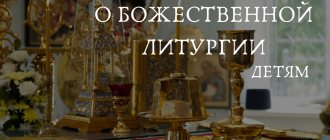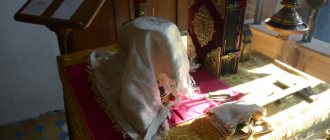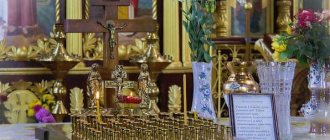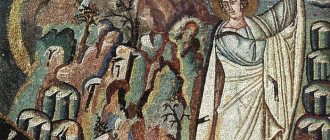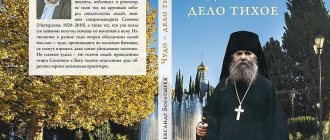During the Eucharistic canon, the priest offers prayers to the Lord God
Then the litany of petition begins again, and then the “symbol of faith” is sung. The “Creed” is sung together with all the parishioners. After which the Eucharistic canon begins. The deacon proclaims: “let us become kind, let us become fearful, bring holy offerings to the world.” At this moment, the priest is in the altar, where he offers prayers to the Lord. At this moment the Eucharistic prayer is read. Next comes the glorification of the Mother of God.
During the Eucharistic canon, the priest offers prayers to the Lord
After the word, the litany of petition begins, and after it the Lord’s Prayer - Our Father, which is sung together with all the laity in the church. This is the late part of the service, at which time everything is drawing to a close.
Next, the curtain over the royal doors closes. The priest from the altar says “holy of holies.” After which the choir begins to sing spiritual chants, or the reader loudly reads prayers for holy communion.
After this, the laity receives communion of the Holy Mysteries of Christ. The curtain over the royal doors opens, and the priest comes out with a cup and proclaims “come with the fear of God and faith.”
After which the priest reads a prayer before communion, after which people come up one by one and receive the Holy Mysteries of Christ. Then the priest enters the altar and places the Chalice on the throne. This is how the Divine Liturgy is performed.
This is how the laity receives communion at the Divine Liturgy
By leaving a comment, you accept the user agreement
Divine Liturgy in Greek means joint work.
Liturgy translated from Greek means “common work.” Believers gather together to glorify God and partake of the Body and Blood of Christ. This is how they will follow the apostles and the Lord himself, who gathered for the Last Supper on the eve of the Savior’s suffering. They drank from the cup and ate the bread that the Lord Jesus Christ gave them.
He told his apostles to perform this sacrament. And only then the apostles taught this to their successors - bishops, priests.
Believers gather together in church to glorify God together and partake of the Body and Blood of Christ
Each ritual ceremony takes place on certain days of the year.
What is ceremonial order? Rite service is a specific sequence of prayers, chants and actions that takes place on certain days of the year during the Divine Liturgy.
When is what ceremony performed? The first is the Liturgy of John Chrysostom, it is celebrated on all days of the year, except weekdays and the days of Great Lent.
The second is the Liturgy of St. Basil the Great, it is celebrated 10 times a year. This is on the eve of the holidays of the Nativity of Christ, the Epiphany, and also on the day of memory of Basil the Great - January 14. The Liturgy is celebrated on the first and fifth Sundays of Lent, as well as on Maundy Thursday and Maundy Saturday.
The Liturgy of Basil the Great is celebrated ten times a year, including on the day of remembrance of the saint
The third liturgy is of the presanctified gifts. This liturgy is held on Wednesdays and Fridays of Lent. During this liturgy, the believer receives the holy gifts - the Body and Blood of Christ. They are lit before, on Sunday. That's why they have that name.
The order of worship at the liturgy must be strictly observed
The service consists of 3 stages. The sequence is such that they follow one after another without interruption.
Stage 1 - proskomedia . This is, in fact, a sacrifice; here bread and wine are prepared in a special way for the sacrament of communion.
Stage 1 of the service in the church - proskomedia. This is, in fact, a sacrifice; here bread and wine are prepared in a special way for the sacrament of communion
Stage 2 - Liturgy of the Catechumens . When does it happen? This happens when all those gathered in the temple are preparing for prayerful participation and the performance of a bloodless sacrifice. Only Orthodox baptized people participate here. And who are the catechumens? These are still those people who have not accepted the sacrament of baptism.
Stage 3 - Liturgy of the Faithful . This is the part of the liturgy where the bloodless sacrifice takes place. Long ago, in Old Testament times, animals were sacrificed. Then Jesus Christ made his sacrifice with his blood on the cross.
The text of the service is different for each liturgy
How is the liturgy conducted? Next we will look at the text of the service - with explanations.
At the very beginning, in the temple, in the altar, the priest prepares all the necessary supplies. Then he puts on a cassock and goes out onto the solea - this is a special elevation from which the altar part of the temples begins.
He turns to the royal doors and begins to read the entrance prayers; he asks the Lord to bless him to celebrate the Divine Liturgy, and also to strengthen and cleanse him from sins and give him the opportunity to perform the sacrament of communion.
He then turns to the laity and asks for their forgiveness. Then the priest enters the altar. At the altar, the priest puts on vestments and reads prayers. What happens in the altar is hidden for the laity.
At the altar the priest puts on his vestments
